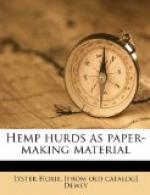Run No. 136 was made on the 300-pound portion of stock from cooks Nos. 293, 294, 295, and 296, and in essentially the same manner as run No. 135. The stock was washed one hour, but given a brush of three hours, and this brush was harder than in run No. 135. Bleach to the extent of 19.8 per cent of the fiber was used, assisted by 1 pint of oil of vitriol, and the resulting color was an improvement over that of run No. 135. After adding 13.5 per cent of clay and sizing with 1.1 per cent of resin size, the furnish was given one-half hour’s light brush, tinted, and run on the machine, which was set at 70 feet per minute. This stock acted better on the wire and gave no trouble on the machine, but it still seemed to be impossible to reduce the wood shives by manipulation of the Jordan refiner. The resulting sheet is an improvement over that produced by No. 135, but is far from satisfactory.
Run No. 138 was made from hurds which, as in all subsequent tests, were sieved on a 11-1/2-mesh wire screen until practically all the loose dirt and sand was removed, which operation caused a loss averaging 3 per cent of the hurds. Stock from cooks Nos. 302 and 303 was used for this run and the increased amount of caustic soda and the increase in the time of cooking gave a stock of better appearance than those of preceding tests.
The stock, amounting to 231 pounds dry weight, was washed and at the same time given a light brush for one hour only, after which it was bleached with 17 per cent of bleach without the addition of acid. Since the preceding paper appeared somewhat weak and had a low tearing quality, it was decided to use a furnish of 15.7 per cent bleached sulphite and 84.3 per cent bleached hemp-hurd stock. After loading with 13.1 per cent of clay and sizing with 1.1 per cent of resin size, the furnish was given a medium brush for one hour, tinted, and run on to the machine at 70 feet per minute. The stock gave no trouble on the machine, but it was impossible to judge the effect of the Jordan refiner, because through an oversight the machine chest had not been cleaned since previous use on an unbleached yucca material. It is believed, however, that sheet No. 138 shows improvement in the preparation of the hurd pulp.
Run No. 139 was made from stock of cooks Nos. 304 and 305, in which still more caustic soda was employed and the time and temperature of cooking were increased, giving a yield of total fiber of 40.7 per cent of the sieved or 39.4 per cent of the unsieved hurds. The cooked stock still seemed to be undertreated, but it must be remembered that in working with any new raw material it is impossible to know in advance how the properly treated material should appear. A washing of one hour was given while the roll was lowered from a light to a medium brush, after which the stock was bleached with 17.1 per cent of bleach without the aid of acid. Since sulphite stock improved the previous paper, this bleached stock was




